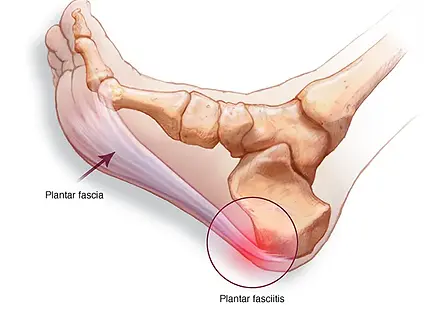Picture This…
When you jump, run and walk the arch of your foot can drop slightly from the impact and the plantar fascia is designed to stretch and support during these activities. But, sometimes, too much pressure can damage or tear the tissues. If the arch drops further than the ability of the plantar fascia, it can cause micro-tears in the Plantar Fascia (connective tissue) and often it happens at the attachment point at the heel. A body’s natural response to injury is inflammation, which results in the heel pain and stiffness felt by those experiencing plantar fasciitis.


Plantar Fasciitis
PLANTAR FASCIITIS 101
Plantar Fasciitis is a painful ailment involving micro-tears and inflammation in the Plantar Fascia. The Plantar Fascia is a band of connective tissue that runs all along the bottom side of the foot. This tissue helps to support the arch of the foot and helps to absorb some of the strain that we put on our feet while walking, running or doing other kinds of vigorous activities. It has an attachment point at heel and this is a common spot for the micro tears to happen. The plantar fascia serves as a shock-absorber. It also functions to protect the longitudinal curvature of the foot while stabilizing the arch of the foot.
Do I have Plantar Fasciitis?
The most common symptom of plantar fasciitis is pain under the foot. The pain is typically felt at the heel, and can feel similar to a bruise or it can be a more intense aching pain. For some, the pain can be more intense when getting out of bed in the morning or getting up from a stationary position. When walking, the pain can lessen but may be persistent. In this case, during the rest period, there is plantar flexion in the foot which allows some healing to occur while the plantar fascia is in a shortened position. So, when you get up to walk, the foot stretches out, and the plantar fascia is expected to lengthen again which can cause micro-tears and pain. Normally, the pain subsides shortly afterward. However, it may occur again if the foot is under
prolonged stress. And may be accompanied by difficulty in bending their feet. If plantar fasciitis persists for an extended period of time, there is a risk of the heel spur formation– a small outgrowth of bone that occurs at the heel bone and points in the direction of the toe.
Plantar Fasciitis is more common with those who have lower arches or flat feet, but those with high arches are not “off the hook” and this foot type can also experience this painful ailment.
WHAT CAUSES PLANTAR FASCIITIS?
For runners, a drastic or sudden increase in distance, along with the use of worn out footwear or lacking proper arch support can be a precursor. According to the American Academy of Orthopaedic Surgeons, plantar fasciitis doesn’t typically have just one definitive cause.

Treatment Of Plantar Fasciitis
If not properly dealt with, this pain can go on for many years. Conservative treatment of the disorder (rest-ice-massage-stretch-support ) is somewhat tedious and can take anywhere from a week to several months, however with these routines, more serious complications can often be avoided. The trouble is, most people cannot stay off of their feet for an extended time. This is completely understandable as we need our feet to get everywhere we need to go. However, if there are micro-tears in the plantar fascia and they never have enough time to fully heal, they can re-tear again and again becoming a chronic ailment.
PRODUCTS TO HELP MANAGE PLANTAR FASCIITIS:
There are a few products that can help to alleviate Plantar Fasciitis:
-
Orthotics / Arch Supports
-
Night Splints (if you have tight calves and tend to sleep with your toes pointed)
-
Massage Rollers / Or roll your feet on a golf ball to break up the scar tissue
-
Warm Epsom Salt Baths
-
Kinesio-Tape
Due to the nature of the heel pain, many people assume that they need a lot of cushioning under the heel. The reality is that properly supporting the arch stops it from dropping, overstretching and re-tearing the plantar fascia again and again.
There are a variety of arches and orthotics out there that can help you. The trick is to find the one that works best for your foot. A biomechanically designed support system helps keep the feet in alignment to give the feet a chance to heal. They also drop off before the heel to somewhat suspend the bones and take the pressure off.
Stretches & Exercises To Help Strengthen & Protect The Feet:
This content is not intended to be a substitute for professional medical advice, diagnosis, or treatment. Always seek the advice of your physician or other qualified health provider with any questions you may have regarding a medical condition.
_edited.jpg)




